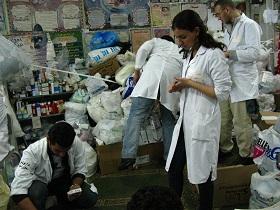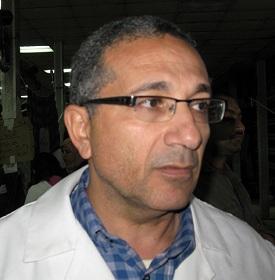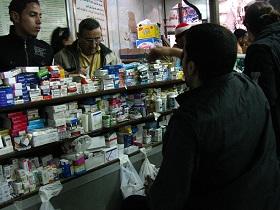Using AI to control energy for indoor agriculture
30 September 2024
Published online 14 February 2011

A small, unimposing mosque tucked behind Cairo's famous Tahrir Square became one of the hotspots during the Egyptian 2011 revolution. As violence broke out, doctors rushed to set up a makeshift field hospital after the city's hospitals refused to treat protesters. Medics are now offering treatment to local residents and many poor families have flocked to the humble hospital.
The dozens of doctors and volunteers resorted to what was at hand to build the hospital: bed sheets, rugs, wooden boards and curtains. In the middle of the mosque stands a sterilization room, complete with plastic sheets draped across whatever surgical equipment could be mustered, and povidone-iodine tanks sit on the ground. At one end of the hospital stand stacked shelves of drugs.
Protesters were sometimes met with extreme violence from police and hired thugs. The field hospital saved hundreds of lives. "On Wednesday [2 February] alone, we had around 700 injured people rushed into the hospital," said Hisham Ibrahim, an otolaryngologist volunteering at the field hospital.
In the beginning the hospital depended on simple medical supplies donated by local residents. "The residents gave us basics, such as packs of cottons, rolls of plasters and antiseptic solutions," said Sameh Ahmed, one of the dozens of young people who helped the doctors in the field hospital.

Later the doctors called for certain medications or equipment to the protesters as the need arose. "It was amazing. When we asked for 100 packs of a certain medicine, we'd get a thousand," said Samia Mohammed, an obstetrician who runs the pharmacy. "People wanted to help anyway they could. We were running out of space to store drugs so residents here lent us two apartments to store the extra drugs since we have such a large stock now."
Ibrahim said that unidentified donors brought in all the equipment used in the hospital, including ice boxes to store insulin and more expensive items such as a sterilization oven. "We even have a small emergency operating room thanks to the generous donations."
There was no official support from the Egyptian Ministry of Health or any neighboring hospitals, added Ibrahim.
A long corridor houses most of the makeshift wards and it's a beehive of activity. Young volunteers are tasked with maintaining order and security, while others are sifting through tens of bags of donations. Doctors dash from one place to the other to check on their patients, clearly worn by the lack of sleep.
Many of the doctors went out to protest against Mubarak's 30 years of rule, but were called upon to work as violence erupted.
"We began to ask our friends from different specialties and nurses to come over and help, and that is how this place started to take shape," said Ibrahim. The doctors would try to get whatever equipment and drugs they could on their way to the small hospital.
"When the violence was at its peak on Friday 28 January and Wednesday 2 February, I personally witnessed crimes against humanity," Ibrahim said grimly. "I saw a man with 30 rubber bullets in his back, which means he was shot from a very short distance with his back to the shooter."
Doctors in the hospital spoke of many cases of protesters shot with live ammunition, some in the head, and others in the neck or abdomen.

"At least 11 or 12 people have died in this hospital since the start," Ibrahim added quietly. "We tried to save everyone. We even offered treatment to the thugs who were actually attacking the protesters if they were captured injured before handing them over to the army."
Hussein Elwan, a vascular surgeon at the nearby Kasr El Aini hospital, which is one of the largest hospitals in Egypt, said they received many calls asking for help on Wednesday after thugs attacked protesters. The hospital managers, however, refused to allow ambulances collect the injured.
"The doctors took their own cars and made their way to Tahrir Square to take people to the hospital. It was really dangerous to go there as thugs blocked every entrance to the square," he said.
Human Rights Watch collected figures from doctors in eight hospitals which puts the death toll from the unrest in Egypt at least 302.
While things in the makeshift hospital have calmed and the worst of the violence ended with Mubarak stepping down, the doctors are still hard at work.
"After things became calmer, our role shifted to taking care of the protesters health, especially ones with chronic diseases," said Ibrahim. As he was speaking, people brought in an unconscious man who suffered a diabetic coma as a doctor rushed to help.
"The hospital is very well-stocked now," said Samia Mohammed who manages the pharmacy. "When people come asking how they can help, we tell them we don't need anything right now." Many hospitals in Egypt cannot make the same claim.
doi:10.1038/nmiddleeast.2011.18
Stay connected: